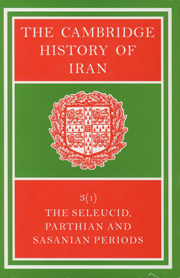Book contents
- Frontmatter
- Introduction
- PART 1 POLITICAL HISTORY
- PART 2 NUMISMATICS
- PART 3 IRANIAN HISTORICAL TRADITION
- 10(a) Iranian Common Beliefs and World-View
- (b) Iranian National History
- PART 4 IRAN AND HER NEIGHBOURS
- Bibliography
- Plate section
- Plate section
- Plate section
- Map 3. The western regions of the Sasanian empire">
- Map 11. The Silk Road from China to the Roman Orient
- References
10(a) - Iranian Common Beliefs and World-View
from PART 3 - IRANIAN HISTORICAL TRADITION
Published online by Cambridge University Press: 28 March 2008
- Frontmatter
- Introduction
- PART 1 POLITICAL HISTORY
- PART 2 NUMISMATICS
- PART 3 IRANIAN HISTORICAL TRADITION
- 10(a) Iranian Common Beliefs and World-View
- (b) Iranian National History
- PART 4 IRAN AND HER NEIGHBOURS
- Bibliography
- Plate section
- Plate section
- Plate section
- Map 3. The western regions of the Sasanian empire">
- Map 11. The Silk Road from China to the Roman Orient
- References
Summary
To be fully comprehensible, Iranian myths and legends and the subsequent development of the Iranian historical tradition must be studied in the context of the Iranian world-view. The Avestan material, although presented in a Zoroastrian redaction, preserves many of the Iranian beliefs which were inherited from remote antiquity and persisted in Iran throughout the Sasanian period. Pahlavi books, too, despite their late composition, have kept for us an essentially pre-Zoroastrian set of beliefs concerning cosmology and the nature of corporeal creation. On the basis of the Avesta, the Rig-Veda, and the conservative Pahlavi literature, it is possible to arrive at an approximation of the development of the Iranian world-view from pagan times to the advent of Islam.
DIVINE BEINGS AND THEIR ALLIES
The Indo-Iranian people believed in a number of gods, mostly symbolizing forces or aspects of nature, who wielded great power over natural events, as well as over man's destiny. A discussion of the Iranian pantheon or Iranian demonology is outside the scope of this chapter. The following remarks are meant to provide only the necessary back-ground in cosmology against which the mythical and legendary history of Iran developed.
Already in pagan times, social development and ethical considerations had given rise to the concept of deities who personified or represented abstract ideas or moral values. Mitra (Av. Mithra), one of the great Indo-Iranian gods, was a protector of pacts and promises, and Varuna, another powerful god, had in his charge rta (Old Pers. arta, Av. aša), the universal order based on truth. Gods were worshipped through ritual sacrifice and prayer in order to ensure their favour and gain their protection.
Keywords
- Type
- Chapter
- Information
- The Cambridge History of Iran , pp. 341 - 358Publisher: Cambridge University PressPrint publication year: 1983
References
- 2
- Cited by



